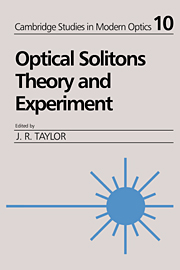Book contents
- Frontmatter
- Contents
- List of contributors
- Preface
- 1 Optical solitons in fibers: theoretical review
- 2 Solitons in optical fibers: an experimental account
- 3 All-optical long-distance soliton-based transmission systems
- 4 Non-linear propagation effects in optical fibres: numerical studies
- 5 Soliton–soliton interactions
- 6 Soliton amplification in erbium-doped fiber amplifiers and its application to soliton communication
- 7 Non-linear transformation of laser radiation and generation of Raman solitons in optical fibers
- 8 Generation and compression of femtosecond solitons in optical fibers
- 9 Optical fiber solitons in the presence of higher-order dispersion and birefringence
- 10 Dark optical solitons
- 11 Soliton-Raman effects
- Index
10 - Dark optical solitons
Published online by Cambridge University Press: 21 October 2009
- Frontmatter
- Contents
- List of contributors
- Preface
- 1 Optical solitons in fibers: theoretical review
- 2 Solitons in optical fibers: an experimental account
- 3 All-optical long-distance soliton-based transmission systems
- 4 Non-linear propagation effects in optical fibres: numerical studies
- 5 Soliton–soliton interactions
- 6 Soliton amplification in erbium-doped fiber amplifiers and its application to soliton communication
- 7 Non-linear transformation of laser radiation and generation of Raman solitons in optical fibers
- 8 Generation and compression of femtosecond solitons in optical fibers
- 9 Optical fiber solitons in the presence of higher-order dispersion and birefringence
- 10 Dark optical solitons
- 11 Soliton-Raman effects
- Index
Summary
Introduction
Although soliton phenomena arise in many distinct areas of physics, the single-mode optical fiber has been found to be an especially convenient medium for their study. As described in the previous chapters of this book, soliton propagation of bright optical pulses has been verified in a number of elegant experiments performed in the negative group velocity dispersion (GVD) region of the spectrum; most recently, transmission of 55-ps optical pulses through 4000 km of fiber was achieved, by use of a combination of non-linear soliton propagation to avoid pulse spreading and Raman amplification to avoid losses (Mollenauer and Smith, 1988). For positive dispersion (λ < 1.3 μm in standard single-mode fibers), bright pulses cannot propagate as solitons and the interaction of the non-linear index with GVD leads to spectral and temporal broadening of the propagating pulses. These effects form the basis for the fiber-and-grating pulse compressor (Nakatsuka et al., 1981; Grischkowsky and Balant, 1982; Tomlinson et al., 1984), which was utilised to produce the shortest optical pulses (6 fs) ever reported (Fork et al., 1987). For both signs of GVD, the experimental results are in quantitative agreement with the predictions of the non-linear Schrödinger equation (NLS).
Although bright solitons are allowed only for negative GVD, the NLS admits other soliton solutions for positive GVD (Hasegawa and Tappert, 1973; Zakharov and Shabat, 1973). These solutions are ‘dark pulse solitons’, consisting of a rapid dip in the intensity of a broad pulse of a c.w. background.
- Type
- Chapter
- Information
- Optical SolitonsTheory and Experiment, pp. 378 - 408Publisher: Cambridge University PressPrint publication year: 1992
- 3
- Cited by



